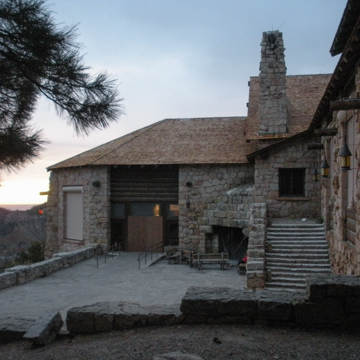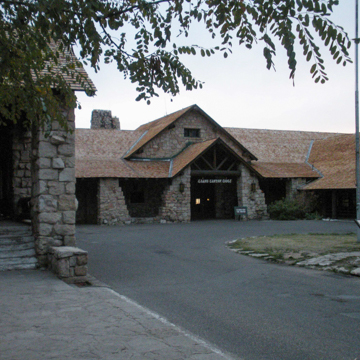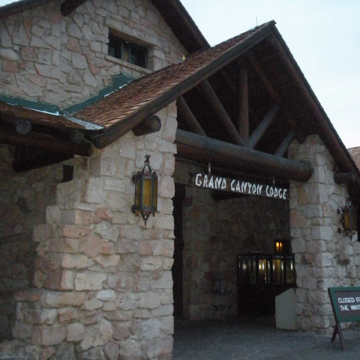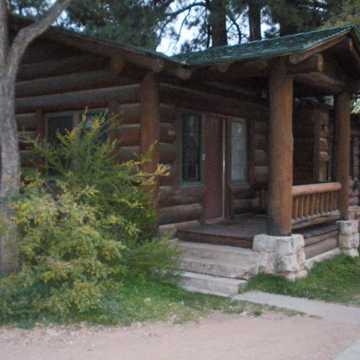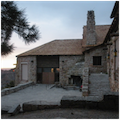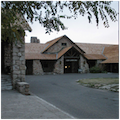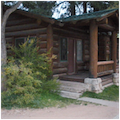You are here
Grand Canyon Lodge
Grand Canyon Lodge houses the only permanent overnight accommodations on the north rim of Grand Canyon National Park. Nestled into the side of the rim on Bright Angel Point, its primary overlook, the Lodge appears as if it emerged organically from the landscape. This remote but significant example of National Park Service Rustic architecture is distinguished by its use of rough-hewn stone and heavy timber.
Since 1905, the venerable El Tovar, which the Santa Fe Railway built on the Grand Canyon’s south rim, was the premier luxury accommodation in the park. Hoping to compete with El Tovar, and other railroad-developed lodges in parks throughout the west, the Union Pacific formed the Utah Parks Company in the early 1920s. In 1927, the company began construction of a magnificent structure on a spectacular overlook on the canyon’s higher and less accessible north rim. A destination lodge on this dramatic site would be the last major hotel in the Union Pacific's “Loop Tour” that included its resorts in Utah national parks. The Grand Canyon Lodge was Union Pacific’s final opportunity to make a memorable architectural statement and definitively establish the railroad's reputation as a leader in Grand Canyon tourism.
Since federal appropriations for parks operations were based on visitor statistics, and overnight lodging was essential to increase those visitor numbers, National Park Service (NPS) director Stephen T. Mather viewed resort development and enhanced (though still limited) public access in a positive light. From the outset, Mather and the NPS assumed design review jurisdiction over the development of concessions within the parks. A philosophy of building in harmony with the parks’ extraordinary natural settings soon emerged, bolstered by the NPS’s direct employment of skilled design professionals and its work with concessions developers similarly committed to quality architecture. On the Grand Canyon’s south rim, for example, the NPS worked with the Fred Harvey Company, with Mary Colter as supervising architect. Key tenets of the NPS building philosophy were the expression of natural materials and details that evoked hand craftsmanship. In some instances, and certainly at the Grand Canyon Lodge, the careful selection and massing of site-specific materials integrated the buildings with nearby rock formations and the pervasive forest.
Along with Colter, Thomas Vint, Herbert Maier, and Charles Wittlesey, Gilbert Stanley Underwood played a significant role in the development of what became known as National Park Service Rustic architecture, or “Parkitecture.” Underwood, who held degrees from Yale and Harvard, began his career as an apprentice in Los Angeles, where he worked in multiple architectural styles then prevalent in California and the West. In the 1920s Underwood designed the lodges at Zion and Bryce national parks in Utah and Ahwahnee Hotel in Yosemite National Park in California, work that earned him a reputation as a master of using natural materials to create buildings that were contextually appropriate and spatially exciting. Possibly recommended by Mather’s NPS landscape staff, including Horace Albright and Daniel Hull (who was Underwood’s friend), the Utah Parks Company invited him back to the Southwest to design their new destination resort on the main overlook at the north rim of the Grand Canyon.
More rustic than the luxurious Ahwahnee, the Grand Canyon Lodge is also more holistically integrated with its natural surroundings. The most significant features of Underwood’s design were numerous terraces overlooking the canyon and, especially, his integration of the stonework of the foundation, walls, and piers into the rim itself, in some places resembling actual rock outcroppings. Walls of Kaibab limestone, one of the canyon’s geologic strata, gave the building a rugged profile with an indigenous feel. Underwood utilized the undulating topography and the density of the coniferous forest to determine placement of the cabins in a non-orthogonal fashion, linking them with meandering paths. By eschewing straight lines, he created an atmosphere capable of fulfilling the out-in-nature expectations of visitors of all means.
Though the main lodge was designed to harmonize with its dramatic surroundings, its remote location made using locally available building materials a virtual necessity regardless of design intentions. Thus, the main lodge was built entirely of wood and stone without a structural core of steel or concrete. A rock quarry was opened two miles from the site, providing the material that experienced stonemasons used to construct the foundation, piers, and other rockwork. A sawmill was assembled at the project site and timber cut from ponderosa pine in the Kaibab National Forest to the north. The mill needed water and power to process the lumber, necessitating construction of a hydroelectric plant on Bright Angel Creek, some 3,400 feet below. Construction crews lived and worked at the remote site, even through the especially harsh winter of 1927.
Unlike the south rim of the canyon, no direct railroad connection to the north rim was ever established. In 1927, the closest Union Pacific station was on the main line in Cedar City, Utah, some 160 miles to the northwest. From there, a road to the north rim was graded, serving first as a conduit for materials and workers needed during lodge construction, and then as a motor coach route bringing tourists and supplies to the completed lodge. Eventually, the Arizona portion of the road was designated State Route 67. By 1929, U.S. 89A had been constructed across the Kaibab Plateau, intersecting with SR 67 at Jacob Lake and providing further access to the remote north rim.
The complex opened on June 1, 1928, ready to accommodate 250 guests in the main lodge, 100 standard cabins, and 20 deluxe cabins. While its initial period of success was dampened by the onset of the Great Depression, a bigger disaster was looming for the new Grand Canyon Lodge. Early in the morning of September 1, 1932, sparks from a fireplace hearth ignited a fire. Flames consumed the main lodge and two deluxe cabins. The cabins were never rebuilt, but the lodge was reconstructed in 1936–1937 with hidden steel structural members (apparently by the Union Pacific rather than as a New Deal program under NPS direction). Remnants of the stone foundation, piers, walls, and chimneys were incorporated into the reconstruction, thus retaining the general layout and rustic character of the original design. Several changes were introduced in the rebuilding: the central observation tower and the log dormitory on the second floor were omitted in the reconstruction and the new roof had a much steeper pitch, presumably to shed heavy winter snows more effectively. The architectural character was modified as well. Underwood’s original design could best be described as Craftsman and Spanish Colonial Revival in style—it was only modestly rustic; the rebuilt lodge was overtly rustic.
It is unknown whether Underwood was involved in the reconstruction since, by then, he was working for the U.S. Treasury’s Office of the Supervising Architect. And although he was known to “moonlight” on occasion, the rebuilding of Grand Canyon Lodge was probably too high profile for his unauthorized participation. In any case, the rebuilt lodge, although less dramatic than the original, remains an iconic example of “Parkitecture” with Underwood’s contributions still discernable.
State Route 67 terminates in a loop drive encircling a small landscaped island embraced by the U-shaped lodge. Flanked by integral porticos, a central entry porch with large double gables, each projecting out of the main roof while supporting an overscaled wrought-iron lamp, faces north toward the drive. The secondary gable rests on massive stepped stone piers with a king-post log truss spanning between them. Interior floor levels step down from the recreation room to the lobby, then to the dining room and sunroom, in concert with the natural slope. Peeled logs conceal steel structural members in the exposed roof trusses over major public spaces, including the lobby and dining room. Interior walls are exposed stone or dark-stained logs with light-colored mortar chinking. Huge wrought-iron chandeliers and sconces illuminate the common spaces throughout the lodge, many decorated with painted and carved Native American symbols.
The main lodge is built of indigenous Kaibab limestone and ponderosa pine logs, with additional log-slab siding on wood frame construction. Intersecting gables with broken pitches are further interrupted by shed and gable dormers; all are finished with wood shakes. Log outlookers extending beyond the barge boards accentuate the gable ends. Stone piers and wall sections of mortared random rubble masonry augment large plate glass windows, especially on the canyon-facing south elevation. Dark-stained log siding with mortar chinking completes the composition.
The lodge’s principal interior spaces include a registration lobby, recreation room, “western saloon,” sun room, dining room, and “buffeteria”; there are also multiple kitchens and various offices and utility rooms. There is direct access to the saloon from outside the lodge, on the eastern leg of the “U”; the entrance to the buffeteria is on the western leg. The canyon overlook to the south features an observation deck with open terraces and an enclosed sunroom above. Purposely overscaled and dominating the stone walled east terrace, a fireplace and stone steps recall Colter’s Hermit’s Rest on the south rim.
Consisting of half-log planks with mortar chinking affixed to wood-frame walls resting on stone piers and footings, are the eighteen rectangular deluxe cabins that survived the 1932 fire. Together with five square quadplexes, these cabins feature chimneys of rough limestone in irregular coursing. Applied vertically at the gable ends, the log siding is horizontal on the primary walls, accentuated by the externally exposed chimneys. Wood shake roofs and peeled logs at the front porches of all units repeat the materials of the main lodge. Windows are typically double-hung pairs with log-slab casings. Exposed stone fireplaces, log rafters, and ridgepoles accentuate the interiors. Only the bathrooms have been modernized. These relatively elaborate cabins offer luxurious comfort in the park’s curated wilderness and the exotic feel of their own miniature lodge.
Smaller and more tightly spaced than the deluxe cabins, the ninety-one standard cabins are rectangular duplexes of whole log construction with log demising walls. Approximately half of the duplexes have small bathroom additions of log-slab siding on wood frame. Their simple, double-pitched roofs are covered with wood shakes. Simple slab steps provide access to the entrance doors in lieu of the more complex porches found on the deluxe cabins. Some of the cabins were moved to the North Rim Campground in 1940, while a few others were converted over the years to house support functions.
In 1972, the Utah Parks Company donated the lodge to the National Park Service, which today leases it to a concessionaire. It was designated a National Historic Landmark in 1987. Having changed very little since 1937, the main lodge is like a time capsule from a bygone age. With its indigenous building materials, humble scale, informal layout of the cabins, incredible views afforded by the main lodge, and the remote, geologically distinct site, the Grand Canyon Lodge is as compelling an attraction in the twenty-first century as when it was first envisioned by the Union Pacific Railroad.
References
Austin, Noah. “Historic Places: Grand Canyon Lodge.” Arizona Highways(February 2015): 16-19.
Bohl, Sarah. “Grand Canyon Lodge.” Arizona State University. Accessed August 16, 2017. http://www.grandcanyonhistory.clas.edu/.
Harrison, Laura Soulliere, “Grand Canyon Lodge,” Coconino County, Arizona. National Register of Historic Places Inventory–Nomination Form, 1986. National Park Service, U.S. Department of the Interior, Washington, D.C.
Harrison, Laura Soulliere. “Grand Canyon Lodge.” In A rchitecture in the Parks: A National Historic Landmark Theme Study. Washington, D.C.: National Park Service, U.S. Department of the Interior, 1986.
PBS. “Canyon Lodges: Grand Canyon.” Great Lodges of the National Parks. Accessed July 28, 2015. http://www.pbs.org/.
Writing Credits
If SAH Archipedia has been useful to you, please consider supporting it.
SAH Archipedia tells the story of the United States through its buildings, landscapes, and cities. This freely available resource empowers the public with authoritative knowledge that deepens their understanding and appreciation of the built environment. But the Society of Architectural Historians, which created SAH Archipedia with University of Virginia Press, needs your support to maintain the high-caliber research, writing, photography, cartography, editing, design, and programming that make SAH Archipedia a trusted online resource available to all who value the history of place, heritage tourism, and learning.




















